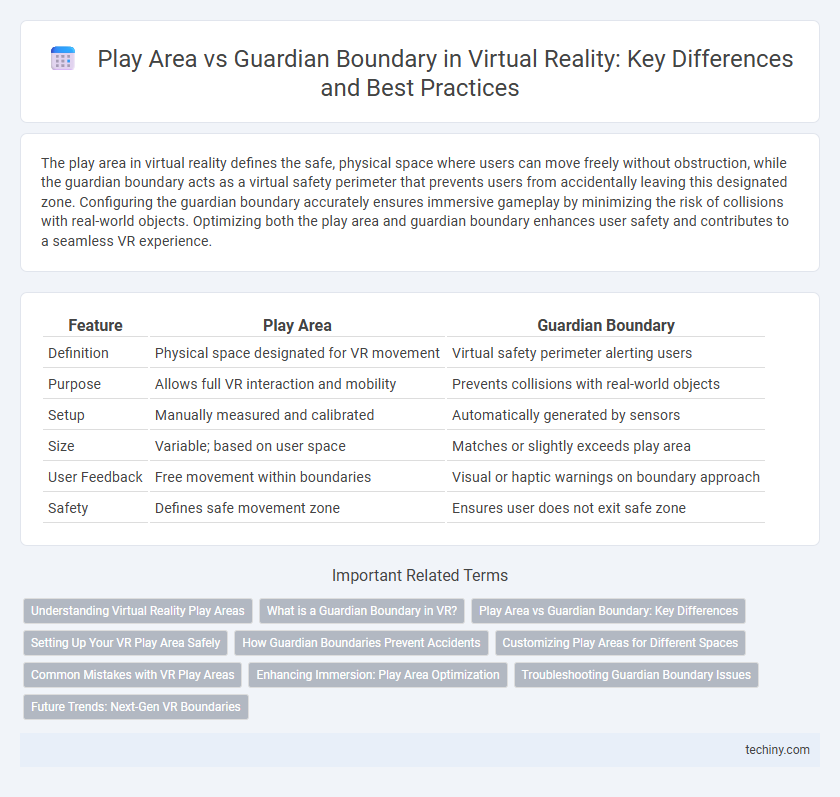The play area in virtual reality defines the safe, physical space where users can move freely without obstruction, while the guardian boundary acts as a virtual safety perimeter that prevents users from accidentally leaving this designated zone. Configuring the guardian boundary accurately ensures immersive gameplay by minimizing the risk of collisions with real-world objects. Optimizing both the play area and guardian boundary enhances user safety and contributes to a seamless VR experience.
Table of Comparison
| Feature | Play Area | Guardian Boundary |
|---|---|---|
| Definition | Physical space designated for VR movement | Virtual safety perimeter alerting users |
| Purpose | Allows full VR interaction and mobility | Prevents collisions with real-world objects |
| Setup | Manually measured and calibrated | Automatically generated by sensors |
| Size | Variable; based on user space | Matches or slightly exceeds play area |
| User Feedback | Free movement within boundaries | Visual or haptic warnings on boundary approach |
| Safety | Defines safe movement zone | Ensures user does not exit safe zone |
Understanding Virtual Reality Play Areas
Virtual reality play areas define the physical space where users can move safely during immersive experiences, while the guardian boundary system establishes virtual limits to prevent users from colliding with real-world objects. Accurately setting up the guardian boundary ensures a secure interaction zone that adapts to different room sizes and shapes, enhancing user safety and comfort. Understanding these distinctions is critical for optimizing VR gameplay, minimizing motion risks, and improving overall spatial awareness in virtual environments.
What is a Guardian Boundary in VR?
A Guardian Boundary in VR is a virtual safety system designed to define the play area limits and prevent users from colliding with real-world objects. It creates an invisible perimeter detected by sensors or cameras, triggering visual or haptic warnings when users approach the boundary. This technology enhances immersive experiences by maintaining spatial awareness and ensuring physical safety during VR sessions.
Play Area vs Guardian Boundary: Key Differences
Play Area in Virtual Reality refers to the physical space defined by users for safe movement, while the Guardian Boundary is a virtual safety perimeter designed by the VR system to prevent collisions with real-world objects. The Play Area is user-defined and often larger, allowing free exploration, whereas the Guardian Boundary dynamically adjusts within this space to provide alerts and restrict movement near potential hazards. Understanding the distinction is crucial for optimizing immersion and safety during VR experiences.
Setting Up Your VR Play Area Safely
Creating a safe VR play area requires distinguishing between the physical play area and the Guardian boundary, which acts as a virtual fence to prevent collisions. The play area should be spacious, free of obstacles, and measured accurately to match the Guardian system's boundaries for optimal safety. Regularly calibrating the Guardian boundary ensures real-time alerts when users approach physical edges, minimizing the risk of injury during immersive VR experiences.
How Guardian Boundaries Prevent Accidents
Guardian Boundaries in virtual reality systems create a customizable safety perimeter that alerts users when they approach physical obstacles, reducing collision risks. By dynamically mapping the play area, the Guardian system ensures users remain within a safe zone, preventing accidental impacts with walls, furniture, or other objects. This proactive spatial awareness significantly enhances user safety and immersion by minimizing disruptive accidents during VR experiences.
Customizing Play Areas for Different Spaces
Customizing play areas for virtual reality environments involves balancing the physical space available with the guardian boundary to ensure safety and immersive gameplay. The play area can be tailored to fit various room sizes by adjusting the guardian boundary, which acts as a virtual safety zone preventing users from colliding with real-world objects. Optimizing this setup enhances user comfort and expands gameplay possibilities by accommodating unique spatial constraints in different environments.
Common Mistakes with VR Play Areas
Many VR users confuse the play area with the guardian boundary, leading to insufficient space that increases the risk of collisions with real-world objects. Overestimating the guardian boundary often results in restricted movement, while underestimating it can cause players to step outside the safe zone. Defining an accurate and sufficiently large play area, distinct from the guardian boundary, is crucial for optimal VR safety and immersion.
Enhancing Immersion: Play Area Optimization
Optimizing the play area in virtual reality enhances immersion by maximizing free movement and reducing the risk of physical collisions within the defined guardian boundary. A well-calibrated guardian boundary ensures users remain safe while enabling fluid interaction with virtual environments, promoting natural, uninterrupted experiences. Strategic play area design balances spatial freedom with safety constraints, resulting in deeper engagement and more realistic VR sessions.
Troubleshooting Guardian Boundary Issues
Troubleshooting Guardian boundary issues in virtual reality often involves recalibrating the play area to ensure accurate spatial tracking and user safety. Misalignment or unresponsiveness of the Guardian system can be resolved by clearing existing boundaries and setting up a new, well-defined play area free from obstacles that interfere with sensors. Ensuring firmware and software updates are current also mitigates tracking errors and enhances the Guardian boundary's reliability during VR sessions.
Future Trends: Next-Gen VR Boundaries
Next-gen VR boundaries will leverage AI-driven adaptive play areas to create dynamic, user-specific guardian boundaries that adjust in real-time to physical obstacles and environment changes. Enhanced sensor fusion and spatial mapping technologies will enable seamless transitions between virtual and physical spaces, minimizing collisions and maximizing immersion. These advancements signify a shift from static play areas to intelligent, context-aware boundary systems that anticipate user movement and environmental factors for safer, more engaging VR experiences.
Play Area vs Guardian Boundary Infographic

 techiny.com
techiny.com